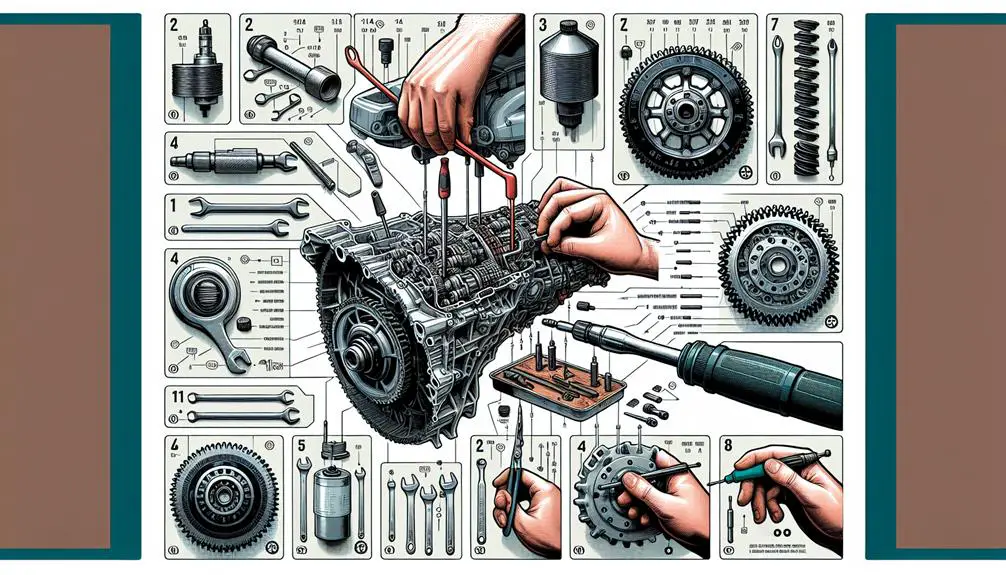Common issues with the Honda Foreman 400 transmission range from hard shifting to complete failure.
These problems can be caused by wear and tear, improper maintenance, or other underlying issues.
Regular maintenance and prompt attention to any warning signs can help prevent major transmission problems.
What Are Common Transmission Problems with the Honda Foreman 400?

Owners of the Honda Foreman 400 often face gear-shifting issues, a common transmission problem that hampers the vehicle’s performance. You might find yourself struggling to switch gears smoothly, which can be frustrating and may even lead to more serious mechanical issues if not addressed.
Besides gear-shifting problems, there are a handful of other transmission issues you should be aware of to keep your Foreman 400 in top condition.
- Grinding Noises: Imagine you’re moving through a tricky trail when a sudden, unsettling grinding noise echoes from beneath you. This sound often indicates a problem with the transmission gears, suggesting they’re not engaging properly.
- Delayed Engagement: Picture yourself starting up your Foreman 400 and attempting to accelerate, only to experience a delay before the vehicle actually begins to move. This hesitation can be a sign of transmission fluid issues or internal wear.
- Leaking Transmission Fluid: Visualize spots or puddles under your parked ATV. These are tell-tale signs of leaking transmission fluid, an important component for your vehicle’s smooth operation.
- Inability to Switch Gears: Imagine the frustration when you try to switch gears, and nothing happens. This issue can leave you stuck in one gear, limiting your ability to move through different terrains effectively.
- Unusual Noises in Neutral: Think about hearing noises from your ATV even when it’s in neutral. This could indicate loose parts or debris within the transmission system.
Being aware of these common problems can help you stay on top of your Honda Foreman 400’s maintenance, ensuring you enjoy every ride without unexpected interruptions.
How Do You Diagnose Transmission Problems in a Honda Foreman 400?
Step 1: Gather Your Tools
Before starting the diagnosis process, ensure you have all the necessary tools. This includes a service manual for your specific Honda Foreman 400 model, a set of wrenches, a screwdriver, and a diagnostic scanner for electronic transmission issues.
Step 2: Check the Transmission Fluid
Begin by examining the transmission fluid as it’s a quick indicator of your transmission’s health. Look for any signs of contamination or low fluid levels, which can significantly affect performance. Refer to your service manual for the correct procedure to check and change the fluid.
Step 3: Listen for Unusual Noises
Operate your Honda Foreman 400 and pay close attention to any unusual noises emanating from the transmission. Grinding or whining noises can suggest internal component issues. This step may require you to open the transmission case for a closer inspection of the gears and clutch, so be prepared for some disassembly.
Step 4: Inspect the Internal Components
If you suspect internal damage, consult your service manual for guidance on safely accessing and inspecting the transmission’s internal components. Look for any signs of wear or damage that could be causing the issues.
Step 5: Utilize a Diagnostic Scanner
For Foreman models with electronic transmissions, a diagnostic scanner can be invaluable. Use it to retrieve any trouble codes from the transmission’s computer. These codes can offer insights into specific problems that mightn’t be easily noticeable.
Step 6: Check the Shift Linkage
Finally, inspect the shift linkage. Some shifting issues may not stem from the transmission itself but from misadjusted or damaged linkage. Carefully examine it for wear or damage and make any necessary adjustments as outlined in your service manual.
Why Is My Honda Foreman 400 Not Shifting Properly?

If your Honda Foreman 400 isn’t shifting properly, it could be due to several underlying issues ranging from low transmission fluid to internal damage. Comprehending the root cause is vital for addressing the problem effectively.
When you’re out on the trails or working on your property, the last thing you want is to be stuck because your ATV won’t shift. Let’s break down some common reasons why your Foreman 400 might be acting up.
- Worn Clutch Plates: Over time, the clutch plates can wear down, making it difficult to shift. Imagine trying to grip a smooth, worn-out surface with gloves; it’s tough to get a good hold. That’s what’s happening inside your transmission.
- Damaged Gears: If you’ve been hard on your ATV, the gears themselves might be damaged. This is akin to trying to fit a key into a lock that’s been tampered with; it just won’t turn smoothly.
- Shift Linkage Problems: The linkage that connects your gear shift to the transmission could be bent or misaligned. Picture trying to use a lever that’s slightly off-angle; it won’t move things as it should.
- Dirty Transmission Fluid: While we’re not diving into fluid specifics here, know that dirty or contaminated fluid can hinder shifting. Think of it as trying to see through muddy water; it’s not clear.
- Sensor Malfunctions: Modern ATVs have sensors that tell the transmission what to do. If these sensors are faulty, it’s like having a broken compass; you won’t get where you need to go.
Addressing these issues will require a bit of detective work and possibly some hands-on repair. But grasping the common culprits can steer you in the right direction.
Can Transmission Fluid Affect My Honda Foreman 400’s Performance?
Yes, transmission fluid can affect your Honda Foreman 400’s performance.
The type and level of transmission fluid are crucial for the transmission’s smooth operation, affecting gear shifting and protecting against wear.
Old, dirty, or improperly leveled fluid can cause shifting difficulties, noise, and sluggishness.
Regular checks and using the correct fluid type are essential for maintaining performance and preventing transmission failure.
What Are the Steps to Fix Transmission Slipping in a Honda Foreman 400?

Step 1: Check the Transmission Fluid
Begin by ensuring the engine is warm and parked on a level surface. Examine the level and condition of the transmission fluid. If the fluid is low, add more until it reaches the appropriate level. Should the fluid appear dirty or have a burnt smell, proceed to change it. This initial step can often resolve slipping issues without needing to delve further.
Step 2: Inspect the Clutch
Evaluate the condition of the clutch, looking for signs of wear and tear. If you possess the skills for ATV maintenance, you can personally inspect the clutch plates and springs. Should these components appear worn, replacing them may enhance the transmission performance of your Honda Foreman 400.
Step 3: Consider Mechanical Issues
If after performing the first two steps the transmission slipping persists, it may hint at a more significant mechanical problem. This could involve worn gears or bearings within the transmission. At this juncture, it’s advisable to consult with a certified mechanic. A professional can conduct a thorough diagnosis and undertake repairs that go beyond basic maintenance, ensuring your ATV operates smoothly again.
How to Prevent Transmission Problems in Your Honda Foreman 400?
Regular maintenance is your best defense against transmission problems in your Honda Foreman 400. Keeping up with the suggested service intervals not only guarantees your ATV runs smoothly but also can prevent costly repairs down the line.
Here’s how you can minimize the risk of transmission issues and keep your Foreman 400 in prime condition.
Comprehending and following the recommended service schedule for your Honda Foreman 400 is critical. This includes oil changes, filter replacements, and inspections of the transmission system. Ignoring these can lead to premature wear and tear.
- Use the right type of transmission fluid. Each ATV model may require a specific type of fluid for optimal performance. Using the wrong fluid can cause damage and decrease efficiency.
- Avoid overloading your ATV. Pushing your Honda Foreman 400 beyond its weight capacity can strain the transmission, leading to potential failures.
- Practice smooth shifting habits. Abrupt or forceful gear changes can wear out the transmission components faster.
- Keep the cooling system in check. Overheating can be detrimental to your transmission’s health. Ensure the cooling system is functioning properly to prevent this.
- Regularly inspect the transmission for leaks or damages. Catching issues early can prevent them from escalating into bigger, more expensive problems.
Taking these steps won’t only prolong the life of your Honda Foreman 400’s transmission but also improve your riding experience.
When Should You Consider a Professional Service for Your Honda Foreman 400’s Transmission?

Seek professional service for your Honda Foreman 400’s transmission when experiencing persistent issues like:
- Difficulty shifting gears
- Slipping out of gear
- Unusual noises (grinding or whining)
- Complete inability to engage gears
If basic troubleshooting such as checking the transmission fluid doesn’t resolve the problem, a professional can provide a comprehensive diagnosis and repair.
Delaying professional intervention for symptoms of transmission failure can lead to more extensive and expensive repairs. Regular maintenance is important, but recognizing when to involve a professional can prevent further damage and ensure your ATV remains in optimal condition.
FAQs
What are the signs of a failing transmission in a Honda Foreman 400?
Signs of a failing transmission in a Honda Foreman 400 include:
- Unusual grinding or whining noises
- Difficulty changing gears
- The ATV slipping out of gear
- A burning smell indicating overheating fluid
- Visible leaks of transmission fluid.
How often should I change the transmission fluid in my Honda Foreman 400?
Change your Honda Foreman 400’s transmission fluid every two years or after 600 hours of use.
If riding in harsh conditions, consider changing it more frequently to avoid costly transmission problems.
Can I use a universal transmission fluid in my Honda Foreman 400?
No, it’s not recommended to use a universal transmission fluid in your Honda Foreman 400.
Always follow Honda’s specific fluid recommendations to ensure optimal performance and prevent potential damage.
What could be causing the foot shifter issue on a 1998 Honda Foreman 400?
The foot shifter issue in a 1998 Honda Foreman 400 often arises from:
- Worn shifter linkage,
- Damaged internal transmission components, or
- Debris accumulation.
Regular maintenance and part replacements are necessary for smooth operation.
How can I address a transmission problem on a 2000 Honda Foreman S 400 that is stuck in a forward gear?
To address a transmission problem on your 2000 Honda Foreman S 400 stuck in gear, first check and replace the transmission fluid if needed.
Inspect and adjust the shift linkage for damage.
If unresolved, consult a service manual or seek a professional mechanic’s assistance.
Why is my Honda Foreman 400 hard to shift, and what are the possible solutions?
To fix hard shifting in your Honda Foreman 400, follow these steps:
- Check and adjust the clutch.
- Ensure the transmission fluid is at the correct level and consider replacing it.
- Inspect the shift linkage for any misalignment or damage and correct as necessary.
What could be the reason behind a 2001 Honda Foreman TRX450S not going into neutral?
The 2001 Honda Foreman TRX450S may not go into neutral due to various reasons. These include a misadjusted or worn clutch, a bent or improperly adjusted gear shift linkage, accumulated dirt in the transmission, or internal damage like worn gears or bearings.
These issues can result in difficulty shifting into neutral and may require troubleshooting and potential repairs to address the root cause. Regular maintenance and periodic inspections can help prevent such issues and ensure smooth operation of the ATV.
How can I troubleshoot and fix a Honda Foreman ES that won’t shift to neutral?
To fix a Honda Foreman ES that won’t shift to neutral:
- Inspect and adjust the shift linkage.
- Check the clutch for wear and proper adjustment.
- Ensure the transmission oil is clean and at the correct level.
If these steps don’t work, seek professional help.
Wrapping Up
In wrapping up, maintaining your Honda Foreman 400’s transmission isn’t as intimidating as it seems. Regular checks and timely fluid changes can keep shifting smooth and prevent major issues.
If you’re facing stubborn transmission problems, diagnosing with the right tools and following our guide can pinpoint the issue. Remember, if it’s beyond a simple fix, turning to a professional is your best bet.
Keep up with maintenance and your Foreman 400 will be powering through trails for years to come.
